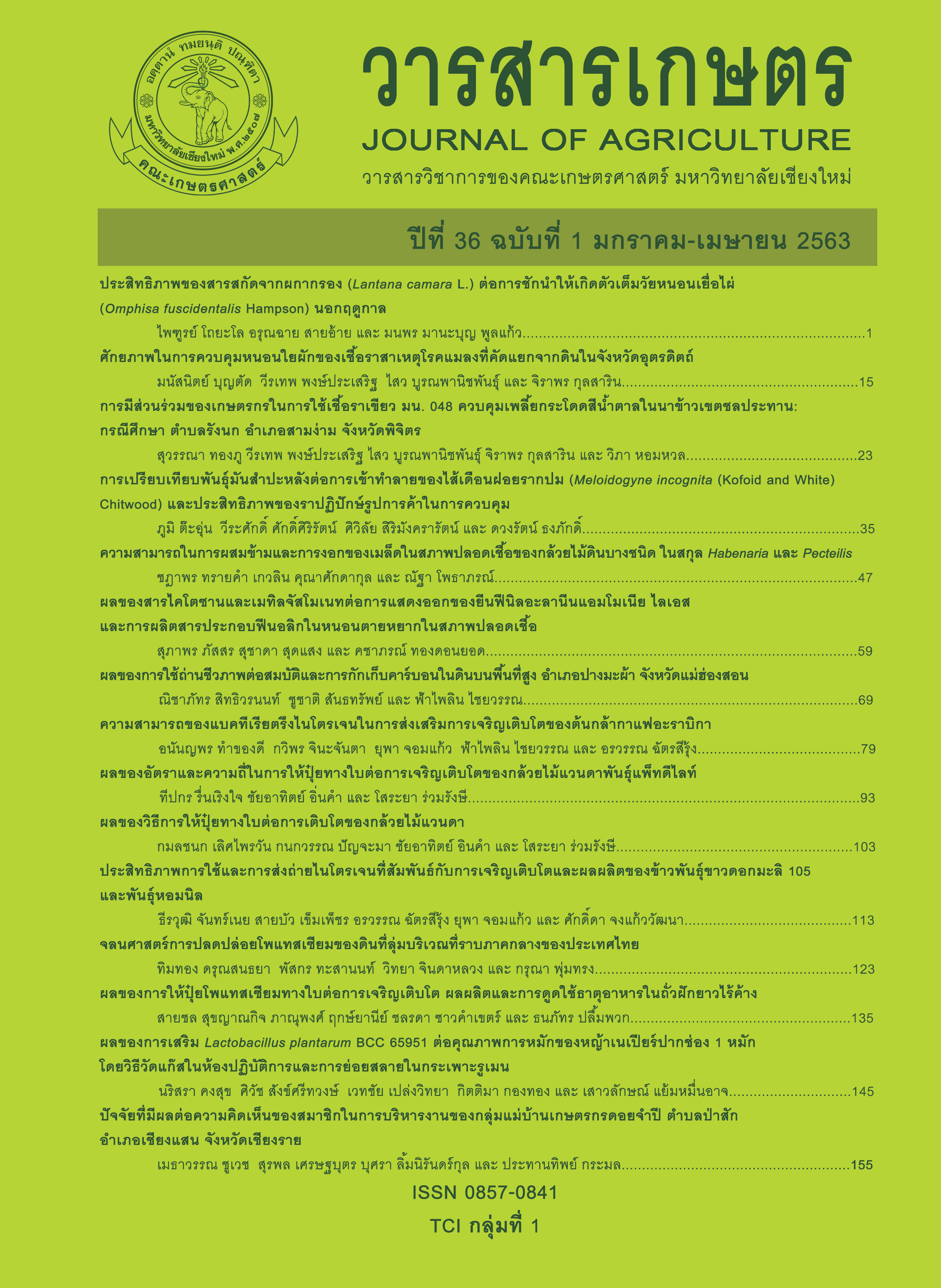Kinetics of Potassium Release of Lowland Soils in Central Plain of Thailand
Main Article Content
Abstract
The study on kinetics of potassium (K) release in lowland soils, Central Plain of Thailand was carried out by selecting representative soils with different soil development from 10 areas. The studied soils included Sapphaya (Sa1, Sa2), Ratchaburi (Rb), Bang Phae (Bph1, Bph2), Bang Len (Bl1, Bl2), Nakhon Pathom (Np1, Np2) and Pak Tho (Pth) soil series. The soil samples were collected at Ap horizon and under Ap horizon to 60 cm depths. The kinetics of K release was studied by extract soils with Mehlich 1 and K content was determined at various times from 1 to 168 hours. The data then were fitted by various equations to describe the release of K from soils. The result showed that Np1 soil series had the highest K release (816 mg kg-1) while Pth soil series had the lowest K release (240 mg kg-1). Kinetics of K release for Bl1, Bl2, Bph1, Bph2, Np1 and Pth were fitted-well by parabolic diffusion and power function equations. These results suggested that kinetic of K release in these soils involved with diffusion process and the rate of K release decreased with increasing time. Kinetics of K release for Sa1, Sa2, Rb and Np2 were fitted-well by zero order equation, suggesting different rate of K release in these soils. At the initial stage of release, K may slowly release from the external sites of clay minerals whereas the rapid K release may occur from interlayer sites of clay minerals afterwards.
Article Details
References
Buol, S.W., R.J. Southard, R.C. Graham and P.A. McDaniel. 2011. Soil Genesis and Classification. 6th ed. Wiley-Blackwell, Chichester. 543 p.
Cox, A.E., B.C. Joern, S.M. Brouder and D. Gao. 1999. Plant-available potassium assessment with a modified sodium tetraphenylboron method. Soil Science Society of America Journal 63(4): 902-911.
Darunsontaya, T., A. Sudcharoen and W. Jindaluang. 2018. Fixation and release of ammonium (NH4 +) in soils containing 2:1 clay minerals. Journal of Agriculture 34(1): 41-53. (in Thai)
Darunsontaya, T., A. Suddhiprakarn, I. Kheoruenromne and R.J. Gilkes. 2010. The kinetics of potassium release to sodium tetraphenylboron solution from the clay fraction of highly weathered soils. Applied Clay Science 50(3): 376-385.
Dhillon, S.K. and K.S. Dhillon. 1992. Kinetics of release of potassium by sodium tetraphenyl boron from some top soil samples of red (Alfisols), black (Vertisols) and alluvial (Inceptisols and Entisols) soils of India. Fertilizer Research 32: 135-138.
Havlin, J.L. and D.G. Westfall. 1985. Potassium release kinetics and plant response in calcareous soils. Soil Science Society of America Journal 49(2): 366-370.
Jardine, P.M. and D.L. Sparks. 1984. Potassium–calcium exchange in a multireactive soil system: I. Kinetics. Soil Science Society of America Journal 48(1): 39-45.
Kittrick, J.A. 1971. Stability of montmorillonites: II. Aberdeen montmorillonite. Soil Science Society of America Journal 35(5): 820-823.
Land Development Department. 2015 . State of Soil and Land Resources of Thailand. Land Development Department, Ministry of Agriculture and Cooperatives, Bangkok. 304 p. (in Thai)
Laungta, S., N. Chittamart and S. Tawornpruek. 2015. Agricultural potential evaluation of rice-based Thai vertisols. Songklanakarin Journal of Plant Science 2(4): 40-51. (in Thai)
McLean, O.E. 1979. Schematic weathering of mica and their transformation into clay minerals: A matter of K release and fixation. pp. 1-13. In: G.S. Sekhon (ed.). Potassium in Soils and Crops. Potash Research Institute of India, Gurgaon, Haryana, New Delhi.
National Soil Survey Center. 1996. Soil Survey Laboratory Methods Manual. Soil Survey Investigation No. 42, Version 3.0. Natural Resources Conservation Service, USDA, Washington, DC.
Pratt, P.E. 1965. Potassium. pp. 1023-1031. In: C.A. Black (ed.). Methods of Soil Analysis: Part 2–Chemical and Microbiological Properties. Agronomy Monograph 9. American Society of Agronomy Inc., Madison, WI.
Rao, C.S., A.S. Rao, K.V. Rao, B. Venkateswarlu and A.K. Singh. 2010. Categorisation of districts based on nonexchangeable potassium: implications in efficient K fertility management in Indian agriculture. Indian Journal of Fertilisers 6(7): 40-54.
Rezapour, S., A. Samadi, A. A. Jafarzadeh and S.H. Oustan. 2010. Impact of clay mineralogy and landscape on potassium forms in calcareous soils, Urmia region. Journal of Agricultural Science and Technology 12(4): 495-507.
Silva, A.A.S.da, J.A. Sampaio, A.B.da Luz, S.C.A. França and C.M. Ronconi. 2013. Modeling controlled potassium release from phlogopite in solution: exploring the viability of using crushed phlogopitite rock as an alternative potassium source in Brazilian soil. Journal of the Brazilian Chemical Society 24(8): 1366-1372.
Sparks, D.L. 2003. Environmental Soil Chemistry. 2nd ed. Academic Press, San Diego. 352 p.
Sparks, D.L., L.W. Zelazny and D.C. Martens. 1980. Kinetics of potassium desorption in soil using miscible displacement. Soil Science Society of America Journal 44(6): 1205-1208.
Suttanukool, P., T. Darunsontaya and W. Jindaluang. 2019. A study on the quantity/intensity relationships of potassium of sugarcane growing soils, eastern Thailand. Communications in Soil Science and Plant Analysis 50(2): 153-163.
Thasanon, P., T. Darunsontaya, W. Jindaluang and C. Khongkaew. 2018. Forms of potassium in paddy soils, Central Plain of Thailand. Songklanakarin Journal of Plant Science 5(3): 58-66. (in Thai)
Thomas, G.W. 1982. Exchangeable cations. pp. 159-165. In: C.A. Black (ed.). Methods of Soil Analysis: Part 2–Chemical and Microbiological Properties. Agronomy Monograph 9. American Society of Agronomy Inc., Madison, WI.
Weaver, R.M., M.L. Jackson and J.K. Syers. 1971. Magnesium and silicon activities in matrix solutions of montmorillonite-containing soils in relation to clay mineral stability. Soil Science Society of America Journal 35(5): 823-830.
Whittig, L.D. 1965. X-ray diffraction technique for minerals identification and mineralogical composition. pp. 671-698. In: C.A. Black (ed.). Methods of Soil Analysis: Part 2–Chemical and Microbiological Properties. Agronomy Monograph 9. American Society of Agronomy Inc., Madison, WI.
Yoothong, K., L. Moncharoen, P. Vijarnson and H. Eswaran. 1997. Clay mineralogy of Thai soils. Applied Clay Science 11(5-6): 357-371.


